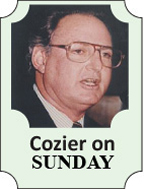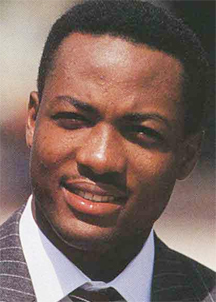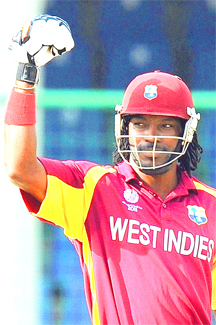It doesn’t require a university doctorate to appreciate the daunting task that faces the West Indies in the three Tests on their latest tour of England.
Simple mathematics, a grasp of the difference between the climate and the cricketing conditions in the Caribbean and the British isles in May and recent history, even taken separately, make the case.

Lawrence Booth, editor of the game’s most prestigious publication, Wisden Cricketers’ Almanack, bemoans the loss of key players to the Indian Premier League (IPL), describing this team as “a watered-down approximation of the real thing.”
Scyld Berry, his immediate predecessor at Wisden, dismisses the youngsters used at the top of the order while the prolonged Chris Gayle saga was sorted out as “waifs and strays” who were “thrown in the deep end and, without anyone to learn from, drowned.”
Fuming as we understandably would be at such comments, the evidence cannot be denied, even with as much optimism as we can muster.
First, the maths. The 14 players England’s selectors are likely to consider for the first Test at Lord’s have 642 Tests, 91 hundreds and 838 wickets between them; the 15 West Indians on tour total 414 Tests, 34 hundreds and 388 wickets (take away Shivnarine Chanderpaul and it drops to 287 Tests and nine hundreds).
Now consider the weather and the pitches.
The latest forecast is for temperatures rarely above 10 degrees over the next week and only slightly less bitter for the coming month or so.
The met officer was spot on in stating that there would be “showers on the south coast” yesterday. They duly came, perhaps more than simply showers, causing the first day of the West Indies’ opening match, against Sussex at Hove to be abandoned without a ball bowled.


“A wider area of showers” is predicted for today and “a washout for Bank Holiday Monday” tomorrow, with further widespread rain during the week.
So it is perfectly possible for the West Indies to turn up at Lord’s on Thursday week without bowling a ball in their two scheduled preparation matches (this one against Sussex and then against the England Lions at Northampton Thursday through Sunday).
Even if they do get in some cricket, they’ll need plenty of the hand warmers they had to purchase in a similarly arctic environment on their hastily arranged, hapless tour of two Tests and three ODIs, also in May, in 2009.
Yet, for all such negative factors, the genuine spirit and harmony within this team, increasingly evident in recent series, encourages some hope.
They are certainly no match for England on paper, they are still to shake off the self doubt created by years of failure on the field and in-fighting off it and their captain continues under relentless pressure to prove his worth as a player. Yet Darren Sammy and his players have demonstrated a constant, refreshing, 100 per cent commitment to their responsibilities. It has not always been so of late.
As the increased, involved crowds in the recent home series against Australia revealed they are winning back the support of those who had become disillusioned with the repeated bickering between the West Indies Cricket Board (WICB) and the West Indies Players Association (WIPA) and, not least, by the losses in the preceding four series since the turn of the 21st century in England, the oldest foe.
The record in the 15 Tests in that time is 12 wins to England, one to the West Indies (the first in 2000) and two draws. It includes three defeats by an innings, two by 10 wickets and two by over 200 runs.
Only two years ago was bleak weather a factor. The Tests in 2000 and 2004 were played in June through August, those in 2007 in late May through June.
Nor were these teams “watered-down approximations of the real thing”. They were all at full strength. They were diluted only by their own indifference.
Bowled out for 61 and beaten in two days at Leeds in 2000, some of the players used the time off to go and see their countryman, Dwight Yorke, perform for Manchester United rather than secrete them in shame and take in additional but “mandatory” net sessions.
While they cheered at Old Trafford, their greatest fan, the late Leslie Armoogam, “Uncle Les”, wept uncontrollably at Headingley. He was not the only one.
In 2004, as England completed a clean sweep of all four Tests, captain Brian Lara chose not to travel by the team coach but drove himself separately from venue to venue in company with a few chosen players.
In 2009, Chris Gayle, then skipper, got into London from his IPL engagements two days prior to the first Test. When the West Indies lost the match within three days, he told a newspaper interviewer that he preferred Twenty20 to the traditional game, “wouldn’t be so sad” if Test cricket died and that he had become so drained by the captaincy he would be “giving it up shortly.”
They were sentiments players already disgruntled by the board’s agreement to undertake such an ill-conceived tour didn’t need to hear from their leader.
While he has become the foremost, and most feared, batsman in Twenty20 cricket, there is now a certain irony in his dedication to representing the West Indies in all three formats, even at the risk and expense of opting out of his next Twenty20 contract with English county, Somerset.
His return as aggressive, self-assured opener with vast experience and a strong record for the West Indies in Tests (91 matches, average 41.65, 13 hundreds, including two triples), ODIs (228 matches, average 30.06, 19 hundreds) and Twenty20 Internationals (20 matches, strike rate 144.49, one hundred) will clearly have an enormous impact on the overall strength of the team, especially the batting that is the weakest link.
Out for as long as he has been, he obviously appreciates what is required of him and he has rarely failed the West Indies with the bat. Yet Sammy felt obliged to make his point on learning of Gayle’s return.
“We as a team have moved on”, he said. “We are not going to let anybody keep use down. We are going to strive to move forward. When Chris joins the set-up he will be coming into a very hard-working environment which he has to fit into.”
“If he is in it, it is all good for us,” he added. “We all know what he is capable of doing and we hope he could fit in nicely and do the job to take West Indies cricket forward.”
They were bold words from a captain whose position remains tenuous in the view of many to a high profile player not known to take kindly to such forthright comments.
But they reflect the kind of changed attitude now needed to drag the team out of the doldrums where it has languished for so long.





